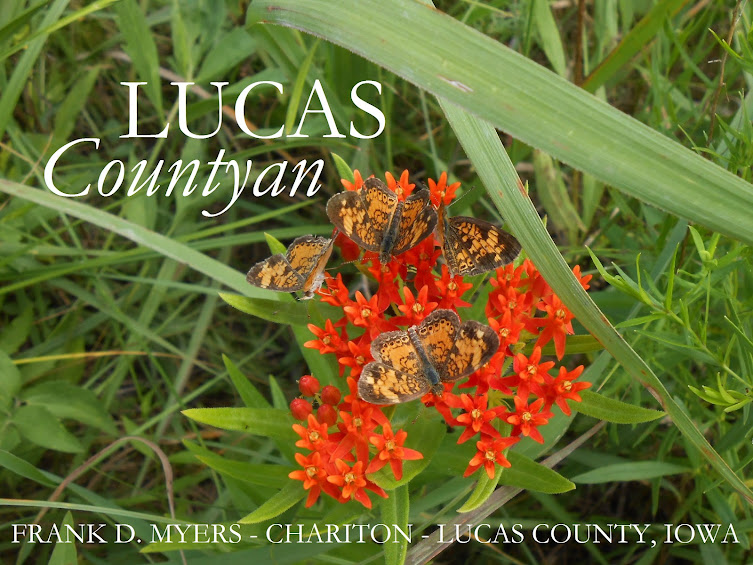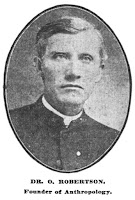I suppose it's time I finally got around to writing something about Chariton's six-year enchantment, 1924-1931, with a gentleman I like to call the Midwest's king of quackery, although there most likely are other contenders for that title.
The good doctor, name now forgotten, turned up years ago in Lucas County's 1978 history described as a "Chickasaw Indian, tall and muscular," who operated a "sanitarium" here during those years --- and caught my attention. "Few, if any, remember his name," the paragraph about him stated. But a bottle that had once contained "Healy and Bigalow's Kickapoo Indian Oil" was found near the former sanitarium site and some concluded that he must have been "Dr. Bigalow."
In fact, he was Orrin Robertson, no more an Indian than my Great-aunt Maude, but among the most accomplished pseudo-medical shysters of his generation.
As a graduate of the State University of Iowa's short-lived Homeopathic Medical Department --- not to be confused with the University of Iowa College of Medicine --- the "doctor" had some medical qualifications. The fact that he also claimed to hold a degree from the "Temple of Moomntaj-Lyumbia, Ka Lama Zurija, India" suggests a somewhat eccentric approach to the field.
.
Homeopathy, today, is considered alternative medicine, but during the late 19th and early 20th centuries, many Americans fell in love with it. So much so, that the U of I established a Homeopathic Medical Department in 1876 and turned it into a full-fledged College of Homeopathic Medicine during 1900, complete with its own hospital at the intersection of Jefferson and Dubuque streets in Iowa City. The decline began in 1910 and the college closed in 1919. Now, the university seems a bit ashamed of itself about all that.
Most of the homeopathic graduates were honorable men. Dr. Robertson was, however, far, far over the top.
Here's his biography from Volume 4 of Edgar R. Harlan's 1931 A Narrative History of The People of Iowa. Robertson paid to have the biography inserted; no independent reporting was involved. The multi-volume work was published during the year Robertson made his final move --- from Chariton to Wichita, Kansas, where he died two years later, age 73.
"ORRIN ROBERTSON, originator and founder of the Vita-O-Pathic Non-Surgical Sanitarium of Chariton, who enjoys a large following of patients and friends, is a man of intellectual gifts, and life long habits of study have brought him in contact with the deepest sources of philosophy, religion and the science of medicine. He was born in Cass County, Missouri, May 28, 1858, son of Jefferson and Martha Robertson. Doctor Robertson has received thirty-one diplomas from various institutions of learning both in America and in Europe. He holds degrees in law and medicine from the University of Iowa. He studied and qualified for the ministry and spent two years in missionary work in old Mexico. For four years he was an instructor in the New York College of Magnetics, holds a diploma in osteopathy, is a fellow of the Eastern Section of Theosophy, is a Doctor of Spiritual Science, Doctor of Philosophy, and in the ministry was identified with the Chirothesian Church of Faith at Los Angeles. He is a member of the Society of Oriental Mystics.
"For some years he was on the lecture platform, devoting most of his attention to topics along new thought lines. He has conducted several sanitaria similar to the one he established at Chariton. He has written extensively on medical and health subjects, and in his practice has held to the central ideas expressed in the slogan "Eat right - Breathe right - Think right."
As the biography states, Robertson was born May 28, 1858, in Cass County, Missouri, but moved soon thereafter with his family to McKinney Texas --- now suburban Dallas --- where the Robertsons put down farming roots.
Heaven only knows how or why Robertson ended up in Iowa City, but he did and earned a law degree there from the University of Iowa during 1882.
He then returned to Texas, but rather than practicing law entered the newspaper business. He edited the Ballinger Eagle and, during 1884, founded the McKinney Democrat, which he edited until April of 1885 when he resigned, reportedly because of ill health.
His newspaper career was not without interest and he was known for fiery editorials and a short temper. The Dallas Weekly Herald reported on June 19, 1884, for example, that "Orrin Robertson, editor of the McKinney Democrat, and Dr. Hoskins, jailer, were arrested yesterday upon indictment by the grand jury. Robertson is charged with assault and carrying a pistol; Hoskins with aggravated assault. The difficulty originated in an article reflecting on the management of the jail."
It's not clear what Robertson got up to after his retirement from newspaper work, but during 1892, in partnership with others, he incorporated the Texas Health College in Coryell County. This seems to have been a diploma mill and most likely a home base for other chicanery.
A little later in the early 1890s, he returned to Iowa City, enrolled in the Homeopathic Medical Department's course of study and was awarded his homeopathic Doctor of Medicine degree during March of 1895.
He apparently returned thereafter to Texas, but it's not clear exactly what he was doing there --- practicing medicine homeopathically, perhaps, certainly continuing the work of the Texas Health College.
Orrin and his various scams were regular features in state medical journals across the United States from the late 1890s through the late 1920s. The Texas Medical Journal for the period July 1897-June 1898 seemed to derive a certain grim pleasure in publishing the following dispatch:
"The Journal is in receipt of a letter from an esteemed correspondent in Fannin county, advising that the notorious Orrin Robertson of Texas Health College (the Mound City myth) fame (or in-fame) was arrested on board of a freight train by City Marshall Bruce Lane, who guarded him until 2 p.m., when the sheriff of Hunt county arrived and took him to Greenville, where he is wanted for infanticide."
+++
During 1901, Robertson established what may have been the first of his "Anthropological Non-Surgical Sanitariums" in Quenemo, Kansas. Eventually, the campus there included three main buildings capable of housing and serving up to 300 patients. Patients anxious for cures of disorders ranging from gallstones and appendicitis to cancer --- without surgery --- flocked in from across the country and paid dearly. If nothing else, Robertson was an effective marketer.
For gallstones, the sanitarium prescribed treatment with Dr. Robertson’s Seven Sacred Oils. These oils reportedly "were obtained from seven different climates and intended for use on seven different zones of the body, to be administered at seven-minute intervals. This grouping of sevens was integral to Robertson’s successful treatment," according to an
Osage (Kansas) County News article published online during October of 2016.
"The campus was not only for those seeking relief from their ailments," according to the News, "but also housed the American University of Anthropology. The university would award diplomas in the degrees offered to paying students. The institution circulated a monthly Journal of Anthropology. This publication would discuss the science used within the sanitarium and answer concerns raised by its opponents."
+++
Robertson left Quenemo behind after a few years, however, and launched new treatment facilities in Kansas City; Excelsior Springs, Missouri; Agra, Oklahoma; and finally at Arkansas City, Kansas.
He became immensely prosperous --- and endured at least three costly and acrimonious divorces. One of his former wives, who held on to a house in Kansas City reportedly valued at $50,000 and once one of the city's finest, reportedly was asked by a judge if she had married Dr. Robertson for love. "No," she replied --- "for the house and lot."
Robertson also began to speculate in oil during these early 20th century years --- and during 1916 while practicing at Arkansas City declared bankruptcy.
When accused by bankruptcy adjudicators of hiding half a million dollars or more worth of assets, he simply vanished --- reportedly taking with him a youthful, pretty school teacher who had been a sanitarium patient. He was nearing 60 at the time.
Six years later, during April of 1922, Robertson was located and arrested by federal authorities at Williston, North Dakota, where he was operating yet another sanitarium, and taken to Fargo to await extradition to Kansas. Once in Kansas, he was jailed to await trial for bankruptcy fraud. There reportedly were three indictments against him.
Robertson hired a skillful Kansas City lawyer, however, who picked apart the technicalities of indictments against him and, during September, a Kansas judge declared them invalid. The good doctor now was a free man, although such of his hidden assets as receivers had been able to find, carefully managed while in receivership and substantially increased in value, were disbursed among his creditors.
Two years later, he washed up quite unexpectedly on the south shore of Chariton.
To be continued ...


































